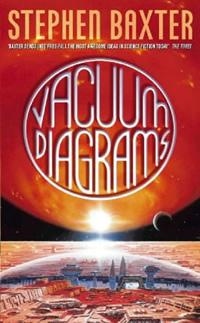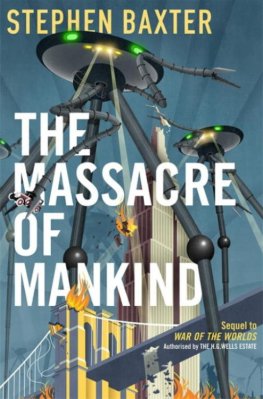Annotation
Ironically, you'll probably appreciate Vacuum Diagrams most after you've put it down. The prolific and acclaimed Stephen Baxter has always been praised for his imaginative and conscientious use of science, and Vacuum Diagrams is no exception. This collection of short stories will leave you ruminating for days over the sprawl of ideas, worlds, and life forms Baxter has woven together.
Filling in the gaps on Baxter's ambitious, almost audacious, 10-million-year timeline called the "Xeelee Sequence," Vacuum Diagrams is a collection of revised, previously published short stories that bridges together his popular novels set in this same "future history" -- Raft, Timelike Infinity, Flux, and Ring. Baxter's universe is rotten with life, from strange tree-stump-like creatures with superfluid ice skeletons to dark matter "birds" to sentient beings composed of pure mathematics. And Baxter's reverence for life's beauty, for its voracious robustness, is hard to resist -- especially when it comes to humanity and its tentative, eager rise. The cycling timeline follows humans as they come into their own as a star-faring race, from their first sporadic steps to their near dominance of the universe and beyond.
Vacuum Diagrams is a great introduction to Baxter for those unfamiliar with him and a good primer for the other "Xeelee Sequence" novels. If you already love Baxter or the other novels in the sequence, Vacuum Diagrams is certainly a safe bet. Besides, any book that sends you scurrying quizzically after your college physics text deserves a closer look. Check it out.
--Paul Hughes (from amazon.com)
Vacuum Diagrams
by Stephen Baxter
For Malcolm Eduards, David Pringle, and Chris Schelling
Foreword
Vacuum Diagrams is a novel based on the short stories which -- together with my novels Raft (1991), Timelike Infinity (1992), Flux (1993), and Ring (1994) -- comprise my "Xeelee Sequence" Future History.
The stories, written between 1987 and 1995, have been revised for this edition; a new timeline is appended; references to the novels are included as footnotes, and a new short story ("Eve") has been included as bridging material.
Of the twenty-two stories included here, four were first published in Isaac Asimov's Science Fiction Magazine, one in SF Age, one in a Writers Of The Future anthology, and eight in Interzone. Two ("Lieserl" and "Cilia-of-Gold") have been included in annual Legend Year's Best SF collections, edited by Gardner Dozois. The other stories mostly appeared in small-press magazines and, while fans are aware of the pieces, they have been largely unavailable before this collection.
Eve
A.D. 5664
The Ghost cruiser hovered between Earth and Moon.
The ship was a rough ovoid, woven from silvered rope. Instrument clusters and energy pods were knotted to the walls. Around me, Ghosts clung to the rope like grapes to a vine.
The blue of crescent Earth shimmered over their pulsating, convex surfaces.
Earth folded up and disappeared.
The first hyperspace hop was immense, thousands of light years long. Then, in a succession of bewildering leaps, we sailed out of the Galaxy.
We fell obliquely to the plane of the disc. The core was a chandelier of pink-white light, thousands of light years across, hanging over my head. Spiral arms -- cloudy, streaming -- moved serenely above me. There were blisters of gas sprinkled along the arms, I saw, bubbles of swollen colour.
Galactic light glimmered over the silvered flesh of the Ghosts, and of my own body.
We reached the Ghosts' base -- far from home, in the halo of the Galaxy.
It was a typical Ghost construct: a hollowed-out moon, a rock ball a thousand miles wide, and it was riddled with passages and cavities. It hung beneath the great ceiling of the Galaxy, the only large object visible as other than a smudge of light.
We descended. The moon turned into a complex, machined landscape below me. Our ship shut down its drive and entered a high, looping orbit. The Ghosts drifted away from the ship and down towards the surface, bobbing like balloons, shining in Galaxy light.
I let go of the ship and floated away from its tangled hull.
Ghost ships and science platforms swept over the pocked landscape, fragments of shining net. All over the surface, vast cylindrical structures gleamed. These were intrasystem drives and hyperdrives, systems which had been used to haul this moon -- at huge expense -- out of the plane of the Galaxy, and to hold it here.
There was quagma down there, I saw, little packets of the primordial stuff, buried in the pits of ancient planetesimal craters. My information had been good, then.
What in Lethe were the Ghosts doing out here?
The world of the Silver Ghosts was once earthlike: blue skies, a yellow sun.
As the Ghosts climbed to awareness their sun evaporated, killed by a companion pulsar. When the atmosphere started snowing, the Ghosts rebuilt themselves.
That epochal ordeal left the Ghosts determined, secretive, often reckless. Dangerous.
They moved out into space -- the Heat Sink -- to fulfill their ambitions.
I had been told the Ghosts were close to completing their new quagma project. I was chief administrator of the Ghost liaison office, representing most of mankind. It was my job to stop the Ghosts endangering us all.
So that I could deal with the Ghosts, I was remade, a decade ago.
I look like a statue of a man, done in silver, or chrome. My legs are pillars. My hands and arms have been made immensely strong. I don't live behind my eyes anymore: I live in my chest cavity. I feel like a deep-sea fish, blind and almost immobile, stuck here in the dark. My mechanical eyes are like periscopes, far above "me."
I can subsist on starlight, and survive the vacuum for days at a time, enfolding my seventy-six-year-old human core -- me -- in warmth and darkness. I have a Ghost doctor; twice a year it opens me up and cleans me out.
I have a face, a sculpture of eyes, nose, mouth. It doesn't even look much like I used to, before. It doesn't matter; apart from the eyes, the face is non-functional, put there to reassure me.
I can run with the Ghosts. I can fly in space, if I choose to. I don't, much. When I'm not dealing with the Ghosts I spend most of my time in Virtual environments.
So my physical form doesn't matter much. In fact, lately I've come to wish the Ghosts had just rebuilt me as a sphere, as they are: simple, classical, efficient.
A Ghost came soaring up to me. It was a silvery, five-feet-wide globe, complex patterns shimmering over its surface. I recognized it from its electromagnetic signature: contrary to myth, Ghosts aren't all alike, at least not to another Ghost.
I greeted it. "Sink Ambassador."
The Ambassador to the Heat Sink floated before me, shimmering; I could see my own distorted reflection in its hide. "Jack Raoul. It has been many years--"
"More than a decade."
"It is pleasant to meet with you. Even if your journey has been a wasted one."
So it began: the endless diplomatic dance. I've known the Ambassador, on and off, for a long time, and we have a certain -- friendship, I guess you'd call it. But none of that is ever allowed to interfere with species imperatives.














